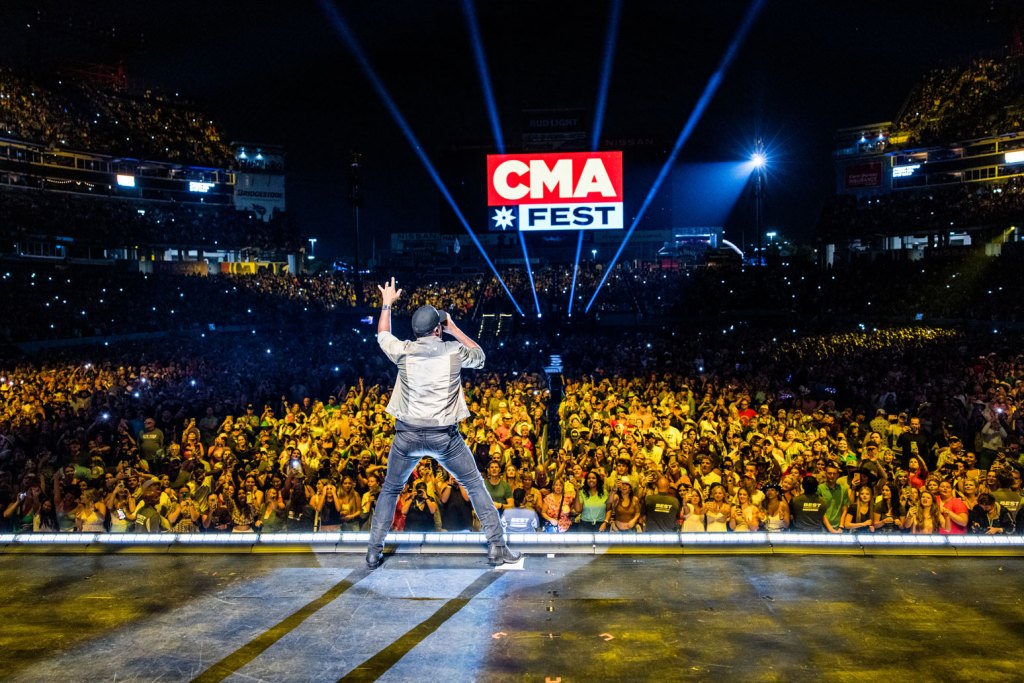When tens of thousands of music fans visit Nashville June 6-9 for the Country Music Association's annual CMA Fest, most of those attendees will see an artist — or two, or 10 — for the first time.
Ironically, the same artists may be meeting one of the musicians playing with them for the first time.
For all the uncertainties fans and industry executives face during the festival, the instrumentalists who lug their amps and guitars through the Downtown footprint represent a stress-filled sub-economy as they live their musical dreams. Many of them work for multiple artists, sometimes selecting eight to 10 acts with up to six different acts during the festival. And in some cases, particularly on the smaller stages of the day, a musician could appear behind an artist they haven't rehearsed with that they've never even met.
“It was almost like a rite of passage,” says drummer Kayleigh Moyer, a Belmont University graduate who is working this year with RaeLynn, Reyna Roberts and, quite possibly, a last-minute call-in artist or two. “If you weren't playing three or more shows during CMA Fest week, as a musician or musician — what were you doing?”
Many artists at CMA Fest — particularly those booked during the nighttime concerts at Nissan Stadium — have their own paid bands. But the daytime stages include a sizable number of acts who haven't made it to that financial level and need to hire a band for the festival, which represents a showcase for some of the genre's most ardent fans. These artists all draw from the same local pool of players and up and coming musicians have the potential to make extra money.
“In a lot of other cases, these artists wouldn't be cool with people doing multiple shows on the same day,” says multi-instrumentalist Kyle Pudenz, who had RaeLynn and Zandi Holup on his calendar 10 days before the festival. space for late requests. “But when it's CMA Fest, they know the pay isn't really sustainable unless you play a lot of shows. I've actually been jokingly calling CMA week 'Musician's Black Friday' for the last several years because it's finally the week of the year where you break the January/February drought.”
Artists famously play CMA Fest for free, introducing themselves to potential new fans, strengthening relationships with existing fans, and generating revenue for the CMA Foundation, which donates proceeds to music education programs.
Musicians are compensated at a lower rate than usual, with CMA paying $170 per show this year under an agreement with the Nashville chapter of the American Federation of Musicians, AFM Local 257. In 2023, CMA paid $120,800 to 617 musicians, according to AFM 257 president Dave Pomeroy averages $195 per musician.
This is not necessarily the only source of income for the week. Some artists who pay their bands higher prices will compensate them beyond the CMA's $170 base. And there are plenty of “non-CMA” shows, including label showcases and open bars on Lower Broadway.
“Every artist that I [play with], I have to fill out separate paperwork for each one,” says drummer Andrew Edmonds, playing this year with Hannah Ellis, Madeline Merlo, Tenille Arts and Carter Faith. “Some artists are really great and say, 'We'll reimburse you for the full performance fee.' Or, you know, 'This headset pays for this.' Each person makes different payments for different things. I have no idea what I'm doing.”
They may also be paid to rehearse, although not every act is, especially as technology has introduced new options. Most acts use click tracks that keep the beat steady on the musicians' in-ear monitors. Supplements can receive “charts” – sheet music that provides chord progressions and song structures – and tapes from previous shows are now commonly available, providing the opportunity to rehearse at home with the artist's actual concerts. “That wasn't as common 10 years ago, getting these before concerts,” says Moyer.
Regardless of their level of preparation, musicians can still count on having an unpredictable experience. Thus, the festival has many nicknames: the “CMA hustle,” according to Pudenz; a “drop and go,” per Moyer. or a “plug-and-pray,” as drummer Sarah Tomek puts it.
Tomek will support Chris Housman and Jenny Teator during official CMA shows and make non-CMA appearances at the weekly Whiskey Jam and events on Lower Broadway at Tequila Cowboy and Jason Aldean's Kitchen + Rooftop Bar.
These CMA gigs are a tough act. When a show ends, the next band has 15 minutes to set up on the same stage. That means plugging guitars into unfamiliar amps, praying all the electronics turn on, and adjusting the in-ear monitor levels for each musician. Drummers have additional problems — most are responsible for a laptop with click tracks and instrument enhancements, and must play on a kit they've never used before, adjusting heights, angles and positions for cymbals, snares and sections.
“It probably takes you five minutes on set to calm down because you've made it, you've arrived, the sound check – everything works, hopefully – and then you can relax,” says Tomek. “By the time you calm down, the set is almost over. And then you move on to the next one.”
Getting to the next one isn't always easy. Most of the stages are within a block or two, but Downtown Nashville is hilly, the crowds can be huge, and once the day starts, the event never stays on schedule. Musicians have been known to text when they are on stage behind an artist to let the next artist know they are running late.
“There's really nothing you can guarantee,” says guitarist Tyler Cain, who works with pop artist Gavin DeGraw. At previous CMA Fests, he has played behind Meghan Linsey and Billy Currington, among others. “Not only are you hoping everything will be on time and go well, but you might also be jumping into a situation where you haven't even had any rehearsal or maybe you don't even know the artist. Like, when you're on stage for them, it's the first time you've met them.”
The schedule tends to work itself out—“I never missed a drop,” Moyer says—and adjusting to surprises as they come has long-term benefits. “I think it makes you a better musician to put yourself in situations where you might be a little scared,” Cain suggests. “Being able to perform quickly, that's a good skill to develop as a musician.”
The biggest skills revolve around overcoming the weather. The heat index tops 90 degrees during CMA Fest, and there's usually a rain shower or two. “Music equipment isn't really designed to operate at that temperature,” notes Pudenz. “If your pedal board is sitting directly in the sun, you might suddenly find that none of your stuff works when you plug it in.”
This also applies to the human body. Tomek says she's “seen stars” while overheating in the middle of a CMA Fest set, though that doesn't allow for presentation shortcuts.
“You still have to be cool,” he says. “It's not like you're going to wear khaki shorts out there. You'll still be wearing your boots and hat, and it's like 100 degrees. It's such a busy week for the cats down there.”
As grueling as it is, musicians appreciate CMA Fest. They came to Nashville to play, and success at the festival builds the belief that they can probably play with anything.
“At the end of the day, the music is the most important thing,” says Edmonds. “No matter what happens, you have to mentally block everything out and just say, 'OK, we're doing this. These next 30 minutes, I'm here and we're going to crush it.” “



